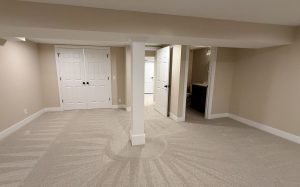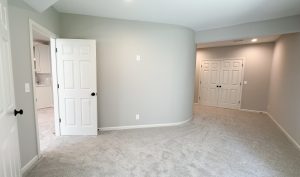Choosing a material for your basement floors may seem like a simple decision, but there are many factors that determine the best option. Finding flooring that’s practical, on-budget, and stylish can be a challenge. But it’s not impossible. Start with a few questions:
What’s your budget?
What will the space be used for?
Who will be using the space?
What is your preferred design style?
Another major factor is installation. If you plan to hire a professional to install it, you can choose based on your preference. However, if you plan to do the job yourself, you should limit your options to materials that are easier to install. Different laying patterns and designs require different levels of skill. Interlocking rubber tiles, for example, are totally doable for the weekend warrior. However, ceramic tile should be left to those with more experience. You should also make sure you have the right tools for the job. If this is a one-time project, you can rent tools from your local hardware store or purchase a floor installation kit online.
Here are a few of the most popular options, as well as the pros and cons of each.
Hardwood Floors
Yes, hardwood floors look great, but they’re not very practical for basements. Wood can warp due to moisture and humidity. Also, basement floors are often uneven, making installation extremely difficult. Because of these factors, installation often requires adhesive, which adds to the cost of an already premium product. If you want the look of wood without the hassle, consider LVT (see below). Besides the cost and logistical issues, it’s also physically hard, so not ideal for spaces where children are present. If you’re really set on using actual wood, consider compromising by using wood in only part of your basement.
Carpet and Pad
Although carpet in living spaces isn’t on-trend, about 55 percent of our clients choose carpet as their basement flooring material. It may not be super fashionable at the moment, but carpet has a lot going for it. It’s inexpensive, kid-friendly, and comes in an endless variety of designs and textures. Another benefit to carpet is that it creates a cozy, soft-to-the-touch living room feel. It might not be the best option for high-traffic basements as it can be challenging to clean. Some may want the room to serve as a den or family hangout spot, so this might be the way to go. If you want the look of carpet, but want something with easy installation, consider carpet tile squares. It may sound like something from elementary school, but the floor can look completely natural with skilled installation.
Luxury Vinyl Tile (LVT)
The fastest growing flooring option is luxury vinyl tile, or LVT. Its purpose is to be the best of both worlds: the high-end look of ceramic tile at a budget-friendly price. It comes in a wide variety of designs and patterns that will align with any decorating style. If ceramic tile isn’t the look you’re going for, LVT can still be a good choice. It can also simulate the look of wood, or even concrete if you’re going for a more modern look. Because it’s easy to install, it’s a solid option for those who opt for our DIY option. Though not as inexpensive as old school vinyl tile, it’s still cheaper than wood or ceramic tile. LVT is about 40 percent of our flooring installation. With its combination of easy installation, looks, and price, it’s no wonder why.
Ceramic Tile
It looks great but it isn’t very practical for the main area of most basements. Ceramic tile can be pricey. It’s also cold in the winter and unforgiving with drops. If you have kids, this surface is not recommended for large areas they may play in. However, it’s maintenance-free and great for small areas like kitchenettes, and we use it in all bathrooms. Often, installation requires at least some floor leveling, which adds to the cost. If you’ve never laid down flooring, installing ceramic tile isn’t recommended. The labor costs are relatively high because of the effort it requires to make the floor look perfect. So if you head in this direction, just know what you’re getting into. We like it as an accent around wet bars and in bathrooms. In other words, its best when used sparingly.
Alternative Flooring options
These options aren’t as common but can be great in the right circumstance.
Rubber Flooring
A great option for playrooms and home gyms, rubber flooring comes in sheets or pieces with interlocking edges. The cushioning it offers is nice for big weights or rambunctious kids.
Epoxy Floor Covering
It’s completely water-sealed, but very hard. This is good if you plan to use your basement as a work room or home gym.
What about moisture?
If you want a more living room type surface, consider floor tiles with a vapor barrier. These tiles include a small platform that creates a gap between the concrete and the floor. If you’re set on carpeting your basement, you might want to consider carpet tiles. By itself, the barrier makes for a more forgiving home gym or playroom surface.
Choose the right contractor for the basement you want
After you’ve decided on the material that’s right for your basement, we recommend working with a contractor. When it comes to choosing the right person for the job, pick an installer that’s experienced laying the flooring of your choice. This is especially true if you wish to use ceramic tile. You’ll want someone who knows how to lay different patterns and sizes. It goes without saying (but we’re still saying it), that you should check references for anyone you hire, especially for a big project like basement flooring. Examples of past projects are also helpful. Keep in mind that most contractors ask for half payment up-front. If you purchase the flooring yourself, many retail outlets have installers available to do the work for you.



